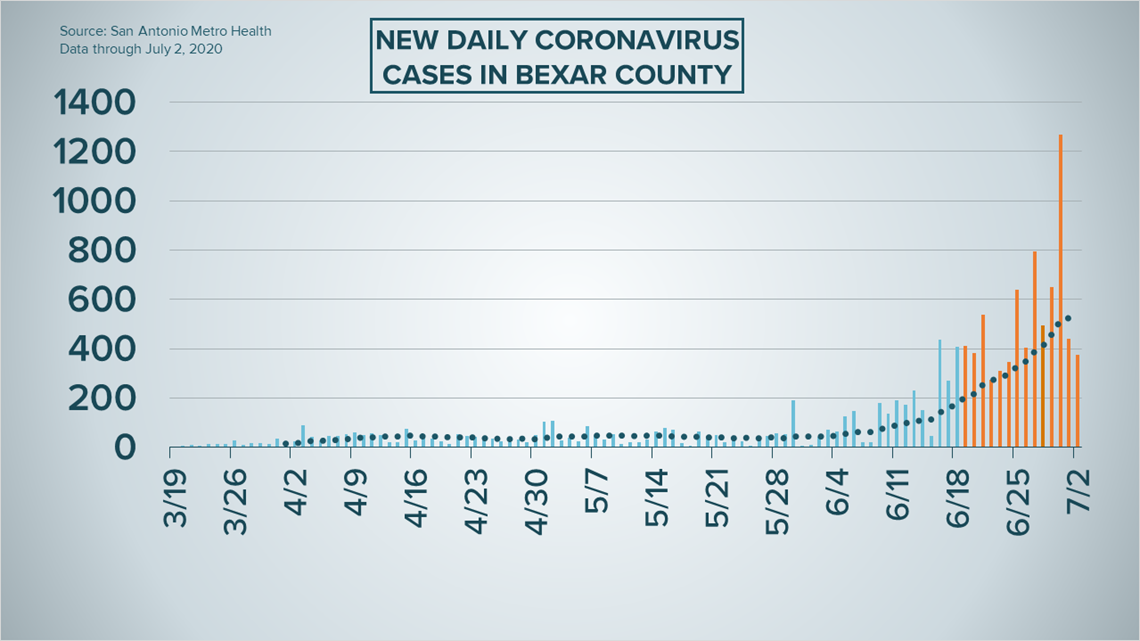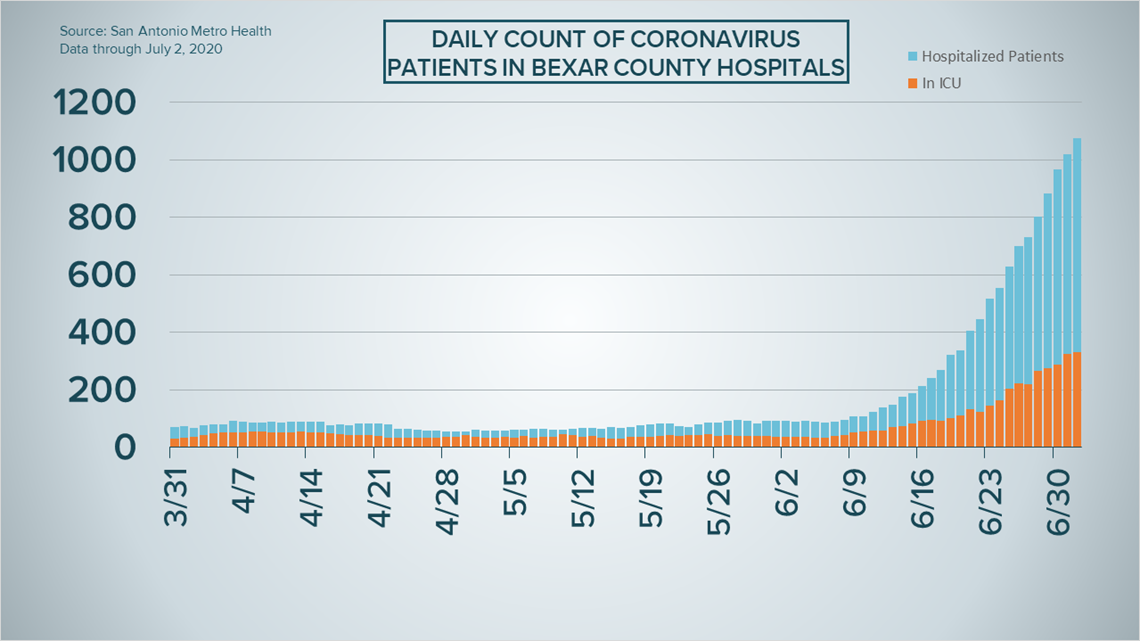SAN ANTONIO — We're tracking the latest numbers from the coronavirus pandemic in San Antonio and across Texas. Here are the latest numbers reported by Bexar and surrounding counties:
- Bexar County: 375 new cases were reported Thursday, along with four additional virus-related deaths. There is a total of 12,878 cases and 115 fatalities in the county. The number of local COVID-19-positive patients currently in area hospitals, meanwhile, rose once again to 1,074. 332 patients are in intensive care, and 180 are on ventilators.
- Comal County: The county reported 71 new coronavirus cases and one fatality Friday. Nine people have now died in the county, while 301 have recovered. The positivity rate has risen to 12.67%, the highest the county has recorded since the pandemic began. As of Friday, there is a total of 907 confirmed and probable coronavirus cases in Comal County.
- Hays County: 126 new cases were reported Thursday, bringing the total to 3,050 cases and seven fatalities in the county. 84% of those cases are considered active, and just under half of the county's confirmed cases are young people between the ages of 20 and 29.
Bexar County reports the full numbers daily at 7 p.m.
How Bexar County is trending:
We're tracking how many coronavirus cases are confirmed in Bexar County each day from the time San Antonio Metro Health began reporting cases more than two months ago. Graphing those daily case numbers along a 14-day moving average provides an accurate picture of the curve in the San Antonio area and the direction we're heading amid the coronavirus.
At a Thursday afternoon briefing, Mayor Ron Nirenberg reported 374 newly confirmed cases of COVID-19 in Bexar County. Meanwhile, four additional virus-related deaths increased the death toll to 115.


A total of 1,074 county residents are in local hospitals with the coronavirus, the highest that number has ever been in the ongoing pandemic. At Thursday's briefing, Nirenberg stressed the importance of staying inside, wearing a mask and social distancing during the upcoming Fourth of July holiday, adding that hospitals are nearing capacity due to the current surge that began two weeks after Memorial Day Weekend.
"We cannot withstand a similar surge after the Fourth of July," he said.
Hospital officails said the current trend of incoming patients is "unsustainable." Meanwhile, Nirenberg on Thursday afternoon tweeted that just 13% of local staffed hospital beds are available to take a COVID-19 patient, a drastic drop from the 27% figure that was reported Wednesday.


Coronavirus in Texas
State health officials reported 7,915 newly confirmed cases of COVID-19 in Texas, the second-highest daily total in the ongiong pandemic, and a marker that the public health crisis continues to worsen ahead of the Fourth of July holiday.
Meanwhile, 44 new deaths from virus-related complications were reported on Thursday. The state's death toll is now up to 2,525. Current hospitalizations also reached a new high-water mark; 478 new COVID-19-positive patients were admitted to hospitals over the last 24 hours, bringing the number of hospitalized Texans on Thursday to 7,382.


Latest Coronavirus Headlines
- What will the long-term effects of COVID-19 pandemic be on our nurses?
- More than 300 children in Texas day cares have caught COVID-19, and the numbers are rising
- US adds 4.8 million jobs in June as unemployment falls to 11.1%
- White House to 'seriously consider' second stimulus check, Treasury Secretary says
- Closing bars to stop coronavirus spread is backed by science
Coronavirus symptoms
The symptoms of coronavirus can be similar to the flu or a bad cold. Symptoms include fever or chills, cough, shortness of breath or difficulty breathing, fatigue, muscle or body aches, headache, new loss of taste or smell sore throat, congestion or runny nose, nausea or vomiting and diarrhea, according to the Centers for Disease Control.
Most healthy people will have mild symptoms. A study of more than 72,000 patients by the Centers for Disease Control in China showed 80 percent of the cases there were mild.
But infections can cause pneumonia, severe acute respiratory syndrome, kidney failure, and even death, according to the World Health Organization. Older people with underlying health conditions are most at risk.
On June 25, the CDC expanded the list of groups at a higher risk of severe illness due to coronavirus.
Experts determined there was consistent evidence these conditions increase a person's risk, regardless of age:
- Chronic kidney disease
- COPD (chronic obstructive pulmonary disease)
- Obesity (BMI of 30 or higher)
- Immunocompromised state (weakened immune system) from solid organ transplant
- Serious heart conditions, such as heart failure, coronary artery disease, or cardiomyopathies
- Sickle cell disease
- Type 2 diabetes
The CDC believes symptoms may appear anywhere from two to 14 days after being exposed.
Human coronaviruses are usually spread...
- Between people who are in close contact with one another (within about 6 feet).
- Through respiratory droplets produced when an infected person coughs, sneezes or talks. These droplets can land in the mouths or noses of people who are nearby or possibly be inhaled into the lungs.
- Some recent studies have suggested that COVID-19 may be spread by people who are not showing symptoms.
Help stop the spread of coronavirus
- Stay home when you are sick.
- Eat and sleep separately from your family members
- Use different utensils and dishes
- Cover your cough or sneeze with your arm, not your hand.
- If you use a tissue, throw it in the trash.
Lower your risk
- Wash your hands often with soap and water for at least 20 seconds. If soap and water are not available, use an alcohol-based hand sanitizer.
- Avoid touching your eyes, nose, and mouth with unwashed hands.
- Avoid close contact with people who are sick.
- Clean and disinfect frequently touched objects and surfaces.
- The CDC recommends wearing a mask or cloth face covering if you have to be out due to an essential service or essential activity such as going to the grocery store.
- If you are 60 or over and have an underlying health condition such as cardiovascular disease, diabetes or respiratory illnesses like asthma or COPD, the World Health Organization advises you to try to avoid crowds or places where you might interact with people who are sick.

